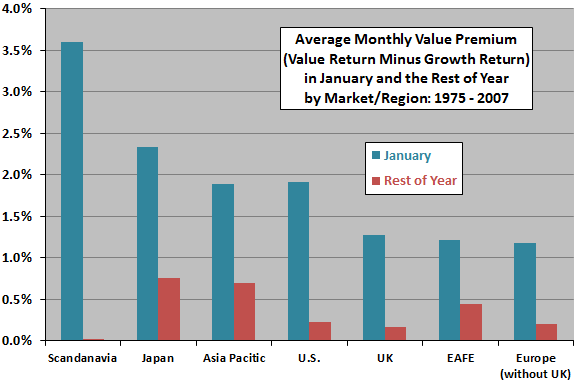Is the value premium seasonal? In their 2012 paper entitled “Is the Value Effect Seasonal? Evidence from Global Equity Markets”, Praveen Kumar Das and Uma Rao investigate the intersection of the January effect and the value premium in stock market indexes around the world. They consider market capitalization-weighted value and growth stock portfolios for the following indexes: Asia Pacific; Europe, Australasia and Far East (EAFE); Europe, with and without UK; Scandinavian countries; UK; U.S.; and, Japan. They define value (growth) stocks as the 30% with the highest (lowest) book-to-market ratios within their respective market indexes. Using monthly stock prices and lagged annual book-to-market ratios for stocks in these markets during 1975 (or inception if unavailable that early) through 2007, they find that:
- Value portfolios outperform growth portfolios in all markets, with the value-growth spread in average gross monthly returns ranging from 0.27% for the UK to 0.89% for Japan.
- In the U.S. market, average gross monthly returns are 1.45% for value stocks versus 1.08% for growth stocks.
- Standard deviations of value portfolio returns are greater than those of growth portfolio returns in all markets except the U.S., suggesting that value stocks are riskier than growth stocks.
- The gross value premium is pronounced for the month of January in all markets, ranging from a 1.1% for Europe without the UK to 3.6% for Scandanavia.
- The gross January value premium for the U.S. is 1.9%.
- Value premiums for months other than January are generally small or statistically insignificant.
- However, high variability (standard deviation of monthly returns) precludes reliable exploitation of a standalone January value premium.
The following chart, constructed from data in the paper, summarizes average monthly gross value premiums for January and the average of other months across equity markets over the entire sample period. The value premium is the difference in average value-weighted gross returns between portfolios holding stocks with the top 30% and the bottom 30% of book-to-market ratios within respective markets.
Results show the importance of January returns in driving the overall value premium.

In summary, evidence from markets around the world indicates that the value premium concentrates in the month of January.
Cautions regarding findings include:
- While the statistics of the January contribution to the value premium inhibit standalone exploitation, value investors might benefit by timing entry (exit) before (after) January.
- Reported returns are gross, not net. Including reasonable trading frictions would reduce these returns, most noticeably in the least liquid markets (perhaps dramatically early in the sample period).
- Sample sizes are modest in terms of number of Januarys (as small as 14 observations for Malaysia), and statistical significance tests assume normal return distributions.
- It would be interesting to add results for 2008-2011 and look for trends over time in both the value premium and its concentration in January.